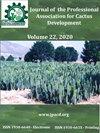块根斯伦贝谢(Schlumbergera truncata)生物量积累在高盆栽密度下生长的毛兰(感恩节仙人掌)
IF 0.4
4区 农林科学
Q4 HORTICULTURE
Journal of the Professional Association for Cactus Development
Pub Date : 2021-09-17
DOI:10.56890/jpacd.v23i.331
引用次数: 0
摘要
观赏行业提供的大多数盆栽多肉植物的生长主要受水、营养、光周期和温度控制的限制,而其他决定,如盆栽种植的植物密度通常基于种植者的经验。为优化斯伦贝热草(Schlumbergera truncata)在高盆栽密度条件下的生物量积累,采用不同根叶首叶数和不喷施合成细胞分裂素6-苄基氨基嘌呤(BAP)的实验设计。以鲜重为基础的生物量积累和茎面积扩张最高的是5个初始叶门和施用bap的盆栽。个体生物量积累的减少和蒸汽面积的扩大与锅密度的增加有关。由于遮阳效应可以被抛弃,对光同化吸收和分配的响应更多地与盆栽根的机械约束有关,而不是与单个根之间的竞争有关。我们的结果表明,当斯伦贝谢在盆中生长时,初始层枝的数量可能高于通常推荐的每盆数量。本文章由计算机程序翻译,如有差异,请以英文原文为准。
Biomass accumulation of Schlumbergera truncata (Haw.) Moran (Thanksgiving cactus) grown under high pot density
The growth of most pot-grown succulents offered by the ornamental industry is limited mainly by water, nutrients, photoperiod, and temperature manipulation, while other decisions, such as: plant density at pot cropping are often based on the grower’s experience. In the present study, to optimize the biomass accumulation of Schlumbergera truncata under high pot density, we performed an experimental design that included different numbers of initials phylloclades and spraying or not with the synthetic cytokinin 6-benzylaminopurine (BAP). The highest biomass accumulation on a fresh weight basis and highest stem area expansion were recorded in pots with five initial phylloclades and BAP-sprayed plants. The decrease in individual biomass accumulation and the expansion of steam area were related to an increase in pot density. Since shading effect can be discard, responses to photo-assimilate uptake and distribution more associated with mechanical constraints on pot roots rather than with a competition between individual roots. Our results suggest that, when Schlumbergera truncata is grown in pots, the number of initial phylloclades may be higher than the usually recommended number per pot.
求助全文
通过发布文献求助,成功后即可免费获取论文全文。
去求助
来源期刊

Journal of the Professional Association for Cactus Development
Agricultural and Biological Sciences-Plant Science
CiteScore
1.10
自引率
33.30%
发文量
10
期刊介绍:
The editors of the Journal of the Professional Association for Cactus Development, are very excited to be a part of the excellent editorial committee and to work together to create the synergism between scientists, growers, legislators, and business people so vital to the development of this industry to serve the people of arid lands.
 求助内容:
求助内容: 应助结果提醒方式:
应助结果提醒方式:


